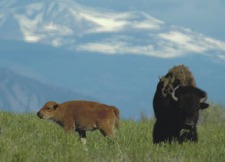Big Game
Homegrown safaris offer the chance to see 'big game' up close
Always dreamed of taking a big game safari but finding overseas travel a bit out of reach?
You can still get up close with big game American big game that is this year or any year, thanks to the preservation efforts of the National Wildlife Refuge System.
The System offers a host of opportunities for outdoor recreation-especially the chance to see wildlife up close, without crowds of tourists. Refuges are often just an hour's drive from most major cities and there is at least one in every state.
Here is a sampling of ideas for a North American viewing safari:
In Wyoming: sleigh rides with elk
For those who love the snows of a Wyoming winter, horse-drawn sleigh rides provide an intimate view of some 8,000 elk on the National Elk Refuge near Jackson.
The refuge, created in 1912, was one of the first big game refuges established as a result of public interest in the survival of the Jackson elk herd. Moose, bison and bighorn sheep also roam the refuge in winter, although catching a glimpse of one is more challenging.
For the 2008-2009 season, sleigh rides are scheduled daily through April 1, 2009, 10 a.m. to 4 p.m. (If snow is sparse, wagons substitute for sleighs.) For info and a virtual sleigh ride, visit
www.fws.gov/nationalelkrefuge/Index.htm
In Colorado: Bison on the range
When the Rocky Mountain Arsenal National Wildlife Refuge in Colorado reintroduced bison on the refuge in March 2007, visits to the refuge swelled. Little wonder.
The refuge is just 11 miles from downtown Denver, and surrounded by suburban neighborhoods and Denver International Airport. It offers two-hour wildlife viewing tours on a trolley bus at 10 a.m. Saturdays, Sundays and Wednesdays.
"Just about anybody on the tour has the opportunity to see the bison," said Sherry James, visitor services manager. "Sometimes they're very close. If we can't see them from outside of their fenced enclosure, we go into their pasture."
Wildlife viewing tours are free, but reservations are required. For information or reservations, call 303-289-0930. For information about Rocky
Mountain Arsenal Refuge, visit
www.fws.gov/rockymountainarsenal/
In Florida: Alligators aplenty
It's unusual not to spot an alligator on St. Marks National Wildlife Refuge in Florida. Visitors are likely to catch sight of one on the 6.8-mile wildlife drive that runs from the Visitor Center to the historic St. Marks lighthouse on Apalachee Bay. Boating on some of the lakes and estuaries on the 68,000-acres refuge or hiking one of its many trails may also provide a peek at the alligators, which can grow to be 14 feet long.
While not as commonly seen as the alligators, the Florida black bear is also making a strong comeback on the refuge, said Refuge Ranger David Moody. "Alligators are pretty close to a given. I see bears about every six weeks," he estimates. Find out more about
St. Marks Refuge online at
www.fws.gov/saintmarks/
In Mane: moose and bear
Aroostock County, Maine, claims to have the densest population of moose and black bears in the lower 48 states, and sightings are quite common from May through September at Aroostock National Wildlife Refuge near Limestone.
The refuge has about six miles of trails through wetlands, spruce-fir forests, and northern hardwood forests. It is open sunrise to sunset, seven days a week. For information, call 207-328-4634.
For more information about
Aroostock Refuge, visit
www.fws.gov/refuges/profiles/index.cfm?id=53630
The mission of the U.S. Fish and Wildlife Service is working with others to conserve, protect and enhance fish, wildlife, plants and their habitats for the continuing benefit of the American people. For more information on our work and the people who make it happen, visit
www.fws.gov.
